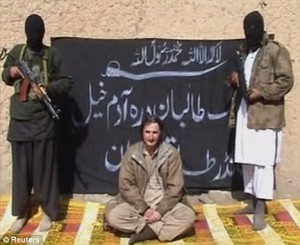NATO and Poppy: The War Over Revenue Part 2
BY Herschel SmithIn NATO and Poppy: The War Over Revenue, we discussed the U.S. and NATO program (then in the planning stages) to eradicate poppy since it provides a revenue stream to the Taliban. The Taliban also create income from marble quarries in Pakistan, extortion of cell phone providers in Afghanistan, ransom from kidnapping, and “protection” of small businesses.
The plans are finalized now and U.S. forces will fire on drug related individuals without proof that they are connected to any military objective.
NATO will remain within international law when it proceeds with new measures to kill drug traffickers in Afghanistan and bomb drug processing laboratories to deprive the Taliban of its main financing, the alliance’s secretary general said Wednesday.
The official, Jaap de Hoop Scheffer, said that “a number of buffers and filters” had been put in place to safeguard the legality of combating what he termed the nexus between the insurgency and narcotics.
“It is according to international law,” he said. “And if nations at a certain stage think that they would rather not participate, they will not be forced to participate.”
Two weeks ago, the alliance was embroiled in controversy after Gen. John Craddock, the NATO commander who is also chief of American forces in Europe, said troops in Afghanistan would fire on individuals responsible for supplying heroin refining laboratories with opium without need for evidence.
In a letter to Gen. Egon Ramms, a German who heads the NATO command center responsible for Afghanistan, General Craddock said that “it was no longer necessary to produce intelligence or other evidence that each particular drug trafficker or narcotics facility in Afghanistan meets the criteria of being a military objective.”
General Ramms questioned the legality of the proposal, warning that it would violate international law and rules governing armed conflict. General Ramms’s letter was leaked, provoking a debate within NATO about the conditions and circumstances under which troops could attack drug laboratories.
Mr. de Hoop Scheffer ordered an investigation into the leak. “Our enemies and opponents in Afghanistan are reading this leak,” he said. “They are not stupid.”
Aside from the effeminate hand wringing over whether this program is “legal,” the program is an attempt to avoid conducting counterinsurgency.
The notions of herion, opium and drug cartels carry connotations of evil, and properly so. But that isn’t the point. When the Marines engaged the Taliban in the Helmand province they purposely avoided any destruction of crops, poppy and otherwise. Turning the farmers into insurgents was not in the mission plan, and the Marines are smart fighters.
Concerning a recent example of Texas National Guard in an agricultural program to compete with the Taliban farms for seed production, we warned that it is one thing to win the competition, and quite another to ensure that the Taliban don’t co-opt the program and turn it to their favor.
Yet another example of this comes from a clever plan to replace poppy with pomegranates.
POMEGRANATES are the key to eliminating heroin, a pioneering charity founder has claimed.
James Brett is spearheading a campaign to persuade farmers in Afghanistan to switch from growing poppies to growing the super-fruit.
He was in Cardiff yesterday as a guest speaker at the annual conference at City Hall of Cymorth Cymru, the organisation that represents people in supported housing.
“I recognised that Afghanistan not only grew the best pomegranates in the world,” said James, who founded the charity Pom 354.
“They also produced more than 90% of the world’s heroin.
“From research I undertook I came to realise that sales of pomegranates on the global market could outstrip the value to Afghanistan of the opium industry.
“With Pom 354 we are putting in place something that is completely viable for the farmers, and that’s vital to the sustainability of the project in Afghanistan.”
Many families in the war-torn country rely on growing poppies, which are turned into heroin, which in turn is smuggled through Europe and has destroyed countless lives in South Wales.
James added: “The tribal elders [in Afghanistan] are very happy that someone has come and started a project they can believe in.
“There’s a lot of unity there and we’re just getting ready to get started on a large scale.
“We’re looking at installing a factory in Kandahar to produce pomegranate concentrate and, if possible, pomegranate jam.
“We’d like to see at the end of this year containers of fresh pomegranate leaving Afghanistan for supermarkets.
“There’s a lot of interest in pomegranates in the West because of its health benefits.
“Over the course of the next 10 years we would like to plant 45.9 million trees, which would cover an area slightly larger than the areas which are used for poppy production.”
The program sounds promising so far. As for the Taliban?
Asked whether he had been in contact with the Taliban, Mr Brett said: “In the complexity of the tribal system in Afghanistan, the Taliban are in every element of society.
“When I talked at the three tribal gatherings, the Taliban were present. I believe that if we don’t communicate with every faction of this problem, we’re not going to solve it.
So what is the solution to the evolving pomegranate problem? How will we prevent it from becoming a revenue stream for the Taliban? Will we shoot pomegranate dealers on sight?
The problem is that we have tried everything – from special operations and air raids on high value targets, and now to poppy eradication – instead of classical counterinsurgency with enough troops to accomplish the mission.
The problem isn’t poppy any more than it is marble quarries, small businesses, wheat seed or pomegranate farmers. There is no solution to the problem of the revenue stream except to kill or capture the Taliban. Why is this so hard for strategists and staff level officers to understand?




